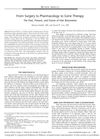Something not talked about in the hair transplant industry Transplants 10/2/2025
Hair transplant success largely depends on individual biology, with many patients needing multiple procedures to achieve satisfactory density. Even top surgeons can't guarantee results, and many people use additional treatments like Minoxidil and Finasteride.
View this post in the Community →
Similar Community Posts Join
5 / 1000+ resultscommunity Are the japanese Finasteride 10 year studies even relevant to caucasian men - especially young ones?
The conversation is about the effectiveness of hair loss treatments, specifically finasteride and dutasteride, in different populations. Some users believe that the results of Japanese studies may not be relevant to Caucasian men, especially young ones, and that East Asians may respond better to these treatments. Others argue that clinical studies should be the basis for decision-making, while acknowledging that individual responses to medications can vary.
community The most depressing things about hair loss for me
The emotional impact of hair loss and the risks associated with common treatments such as finasteride, dutasteride, minoxidil, RU58841, and Fluridil. People discussed their personal experiences with these treatments, including potential side effects and lowered fertility. Hair transplants were also mentioned as a possible solution.
community If you can give one advice to your younger self then what that would be?
Users discussed hair loss treatments, specifically minoxidil and finasteride. They shared personal experiences and advice on starting these treatments early.
community 5 month results on natural protocol, i made a post after 3 mont of treatment wich you can find in my profile. I used different massages(detumescence therapy, wooden brush, tom hagerty exercises)vitamins(d3,fish oil, biotin,msm, magnesium) drank green tea and ate pumpkin seeds( reduces dht)
The user "Zealousideal-Pack340" shared their 5-month results on a natural hair loss treatment protocol, which included massages, vitamins, green tea, and pumpkin seeds. Some users suggested using medications like finasteride and minoxidil for better results, while others criticized the effectiveness of natural remedies. Overall, there was no clear consensus on the progress of the user's hair regrowth.
community The no BS guide to saving your hair without finasteride (improvement in 90% of patients in the study) with a low side effect profile or improvement in 100% of patients but a higher side effect profile and increased dosage. The future is here?
Hair loss treatments, specifically the use of oral minoxidil in combination with micro-needling. Oral minoxidil has been found to improve hair density in 90% of patients with a low side effect profile, but using 5mg per day can result in higher side effects including hypertrichosis and edema. Other treatments mentioned include finasteride and RU58841.
Related Research
6 / 1000+ results
research From Surgery to Pharmacology to Gene Therapy: The Evolution of Hair Restoration Techniques
Hair restoration has evolved from surgery to drugs to potential gene therapy, with improved results and ongoing research driven by high demand.

research A Review of the Treatment of Male Pattern Hair Loss
Finasteride and minoxidil work best together for hair loss.

research Phytochemicals as Emerging Therapeutic Agents for Alopecia Treatment
Plant-based chemicals may help hair growth and prevent hair loss but need more research to compete with current treatments.
research The Mechanistic Insights Into The Application Of Retinoids And Possible Adjunct Therapeutic Treatment To Androgenic Alopecia
Retinoids may improve hair growth in androgenic alopecia when used with other treatments.

research Experimental and Early Investigational Drugs for Androgenetic Alopecia
New hair loss treatments may include topical medications, injections, and improved transplant methods.

research Controlled Clinical Trial for Evaluation of Hair Growth with Low Dose Cyclical Nutrition Therapy in Men and Women Without the Use of Finasteride
Low dose cyclical nutrition therapy can consistently and safely improve hair growth and density without needing anti-androgens.